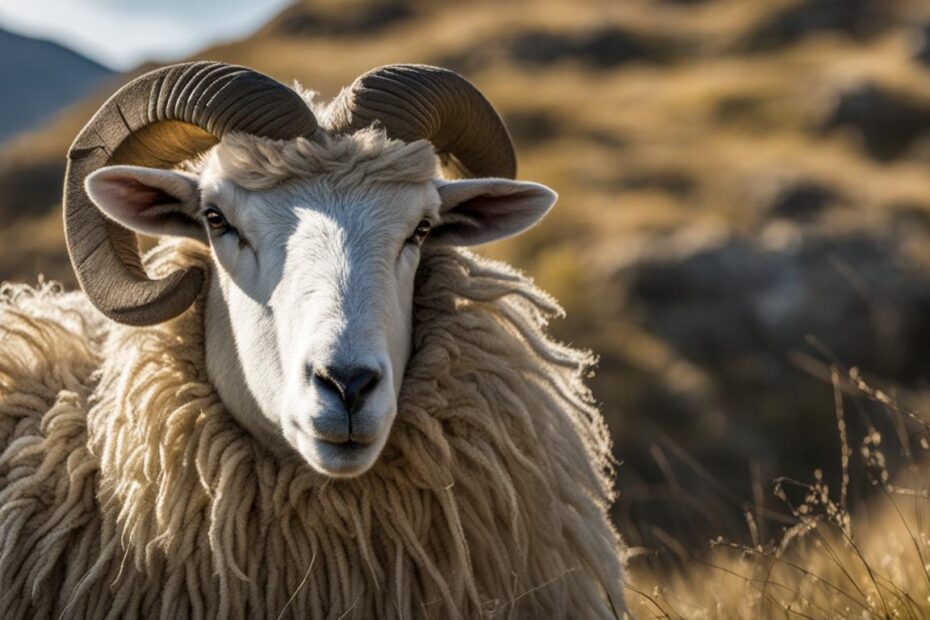Have you ever wondered how wild sheep manage to shed their wool without human intervention? Unlike their domestic counterparts, wild sheep have a natural shedding process that allows them to adapt to changing seasons and survive in the wild. Let’s explore the intriguing mechanisms behind this fascinating phenomenon.
Key Takeaways:
- Wild sheep have a natural shedding process that allows them to lose their wool without human intervention.
- Unlike domestic sheep, wild sheep can survive in challenging terrains and defend themselves against predators.
- The shedding of wool is part of the seasonal survival strategy for wild sheep, helping them adapt to changing weather conditions.
- Wild sheep thrive in diverse habitats, from alpine regions to deserts, thanks to their adaptation skills.
- There are four identified species of wild sheep, each with unique characteristics and adaptations.
Surviving in Challenging Terrain
Wild sheep are remarkable creatures that have adapted to thrive in challenging terrain. Their survival in these environments is made possible by their climbing ability, defensive strategies, and impressive physical characteristics.
One of the key factors that enable wild sheep to survive in difficult terrain is their incredible climbing ability. With their four strong hooves and low center of gravity, wild sheep can navigate steep and rocky slopes with ease. This allows them to reach food sources that are inaccessible to other animals and predators. Their exceptional climbing skills also serve as a means of protection, as they can escape to higher ground whenever they sense danger.
In addition to their climbing ability, wild sheep have developed defensive tactics to fend off potential predators. Their hooves, which are not only used for climbing but also for kicking, can deliver powerful blows to potential threats. This serves as a deterrent and allows them to defend themselves effectively. Furthermore, wild sheep are known to run at impressive speeds, reaching up to 20 mph. This agility and speed give them an advantage when evading predators in their rugged habitats.
“Wild sheep are masters of survival in challenging terrain, using their climbing prowess and defensive abilities to thrive in rocky environments.” – Wildlife Expert
Overall, the ability of wild sheep to survive in challenging terrain is a testament to their remarkable adaptations. Their climbing skills, defensive strategies, and physical characteristics combine to create a species that can not only endure but thrive in some of the harshest environments on Earth.
The Seasonal Survival Strategy
Wild sheep have developed a remarkable seasonal survival strategy that enables them to thrive in challenging environments. One essential aspect of this strategy is their natural wool shedding process. As the seasons change, wild sheep undergo a molting process to adapt to the weather conditions. By shedding their winter fur, they are able to regulate their body temperature and withstand the harsh elements of their habitat. This shedding process occurs in July when food sources are abundant, allowing the sheep to gain weight before the molting begins.
Grazing habits also play a crucial role in the seasonal survival of wild sheep. During the spring and summer, when the mountaintops are carpeted with lush flora, wild sheep graze happily, consuming nutrient-rich vegetation to fatten up for the winter ahead. This abundant food supply helps them build up energy reserves and maintain their health. However, as the seasons transition and food scarcity becomes a challenge, wild sheep demonstrate their remarkable adaptability. They can survive on small amounts of flora found between rocks and under thin layers of snow, making the most of whatever sustenance is available to them.
“The shedding of wool and the grazing habits of wild sheep are remarkable examples of their ability to adapt to changing seasons and environmental conditions.” – Dr. Jane Shepherd, Wildlife Biologist
Wild sheep’s ability to rely on limited food sources during times of scarcity is a testament to their resilience. They have evolved to make the most of their surroundings, utilizing their grazing habits and wool shedding process as survival mechanisms. This seasonal strategy allows them to navigate and thrive in diverse habitats, from alpine regions to desert climates, showcasing their remarkable ability to adapt to various environmental challenges.
| Seasonal Survival Strategies of Wild Sheep | Grazing Habits | Wool Shedding Process |
|---|---|---|
| Spring and Summer | Wild sheep graze happily on nutrient-rich flora, gaining weight and building energy reserves. | No wool shedding occurs during this period as the thick winter fur provides insulation. |
| July | Food sources are abundant, allowing wild sheep to gain weight before the molting process. | Wild sheep shed their winter fur, adapting to changing weather conditions. |
| Autumn and Winter | Food scarcity becomes a challenge, but wild sheep can survive on limited vegetation found between rocks and under thin layers of snow. | Wild sheep remain with their newly molted fur, providing insulation and protection during the cold months. |
Through their seasonal survival strategy, wild sheep demonstrate their ability to adapt and thrive in diverse habitats. Their grazing habits and wool shedding process enable them to overcome food scarcity and regulate their body temperature, ensuring their survival in challenging environments.
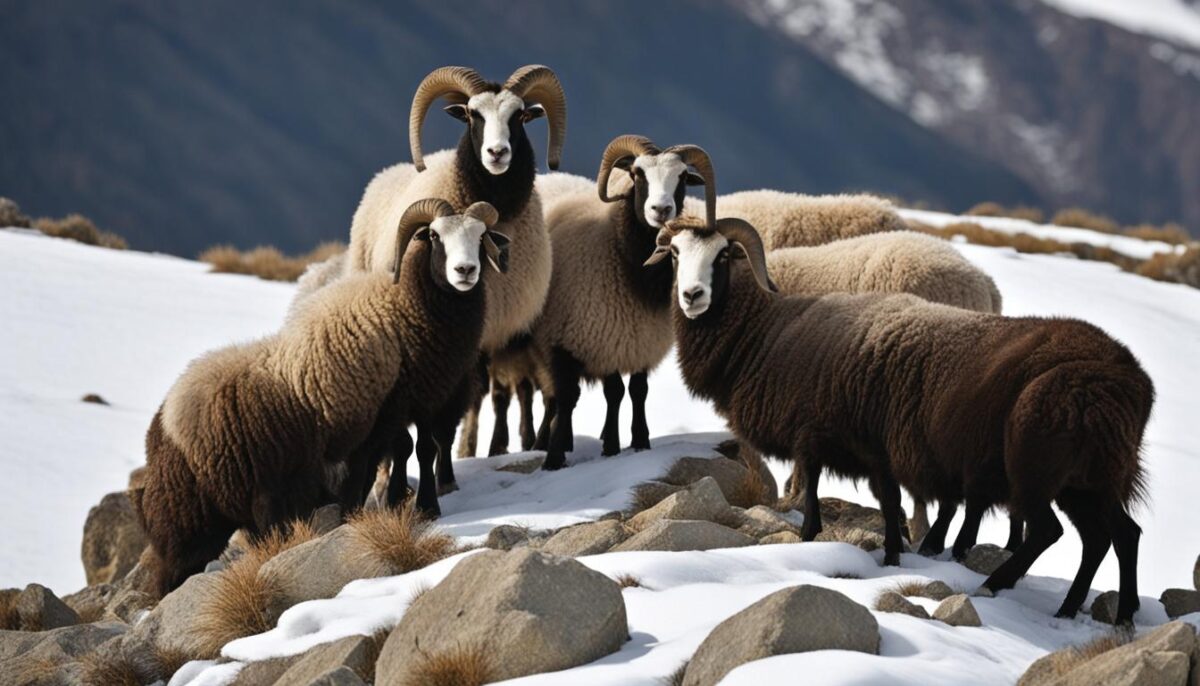
Thriving in Diverse Habitats
Wild sheep have proven their incredible adaptability by successfully inhabiting a wide range of diverse environments. From alpine regions to desert climates, wetlands to hillsides, these resilient creatures have thrived in various habitats throughout history. Their remarkable ability to adapt and survive in different surroundings showcases their evolutionary prowess.
One of the key features that enable wild sheep to thrive in diverse habitats is their impressive physical adaptations. Their horns, for example, serve a dual purpose of defending against predators and establishing dominance within their herds. These strong and sturdy horns are essential for their survival, allowing them to protect themselves from potential threats and assert their status within the social hierarchy.
In addition to their physical adaptations, wild sheep also possess behavioral traits that contribute to their success in diverse habitats. They have developed specialized grazing habits that enable them to find sources of food even in challenging environments. During times of food scarcity, they can survive on small amounts of flora found between rocks and under thin layers of snow. This ability to sustain themselves on limited resources further demonstrates their resilience and adaptability.
The Importance of Habitat Conservation
The ability of wild sheep to thrive in diverse habitats is a testament to the importance of habitat conservation. Preserving the natural environments where these magnificent creatures reside is crucial for their continued survival. By protecting their habitats, we can ensure that future generations will have the opportunity to witness the awe-inspiring beauty of wild sheep and appreciate their remarkable adaptations.
Table: Wild Sheep Habitat and Adaptations
| Species | Habitat | Adaptations |
|---|---|---|
| Dall sheep | Alpine regions | Strong climbing abilities, thick coat for insulation |
| Bighorn sheep | Mountainous terrains | Impressive agility, curved horns for defense and dominance |
| Stone sheep | Rocky mountain slopes | Excellent camouflage, sturdy hooves for navigating rocky terrain |
| Desert bighorn sheep | Desert regions | Water conservation abilities, heat tolerance |
By understanding and appreciating the diverse habitats where wild sheep thrive, we can gain valuable insights into the wonders of the natural world. Their adaptations and ability to survive in challenging environments inspire us to cherish and protect the biodiversity that exists within our planet.
Exploring the Different Species
Wild sheep exhibit incredible diversity, with four distinct species that have adapted to survive in different environments. Let’s take a closer look at each species:
Dall Sheep (Ovis Dalli)
Dall sheep are known for their striking white coats and impressive agility. They inhabit the mountain ranges of Alaska and parts of western Canada. These sheep have adapted to life in the harsh alpine environment, where they navigate treacherous cliffs and steep slopes with ease.
Bighorn Sheep (Ovis canadensis)
Bighorn sheep are renowned for their massive curled horns, which can weigh up to 30 pounds. They inhabit various habitats across North America, including rocky mountainous regions, deserts, and grasslands. Bighorn sheep are highly skilled climbers, allowing them to access food sources and evade predators.
Stone Sheep (Ovis dallei stonei)
Stone sheep, also known as BC mountain sheep, are found in the northern Rocky Mountains and coastal regions of British Columbia, Canada. They exhibit a range of coat colors, from dark brown to gray. Their habitat consists of rugged landscapes, and they rely on their climbing abilities to survive in these challenging environments.
Desert Bighorn Sheep (Ovis canadensis nelson)
Desert bighorn sheep are adapted to live in arid desert regions of North America, including the southwestern United States and Mexico. They have unique physiological adaptations that enable them to conserve water, such as the ability to concentrate their urine and extract moisture from their food. These sheep are well-suited to the extreme temperatures and limited water sources of their desert habitat.
Each species of wild sheep possesses distinct characteristics and adaptations that allow them to thrive in their specific habitats. From the snowy mountains to the arid deserts, these remarkable animals have found ways to survive and flourish in diverse environments.
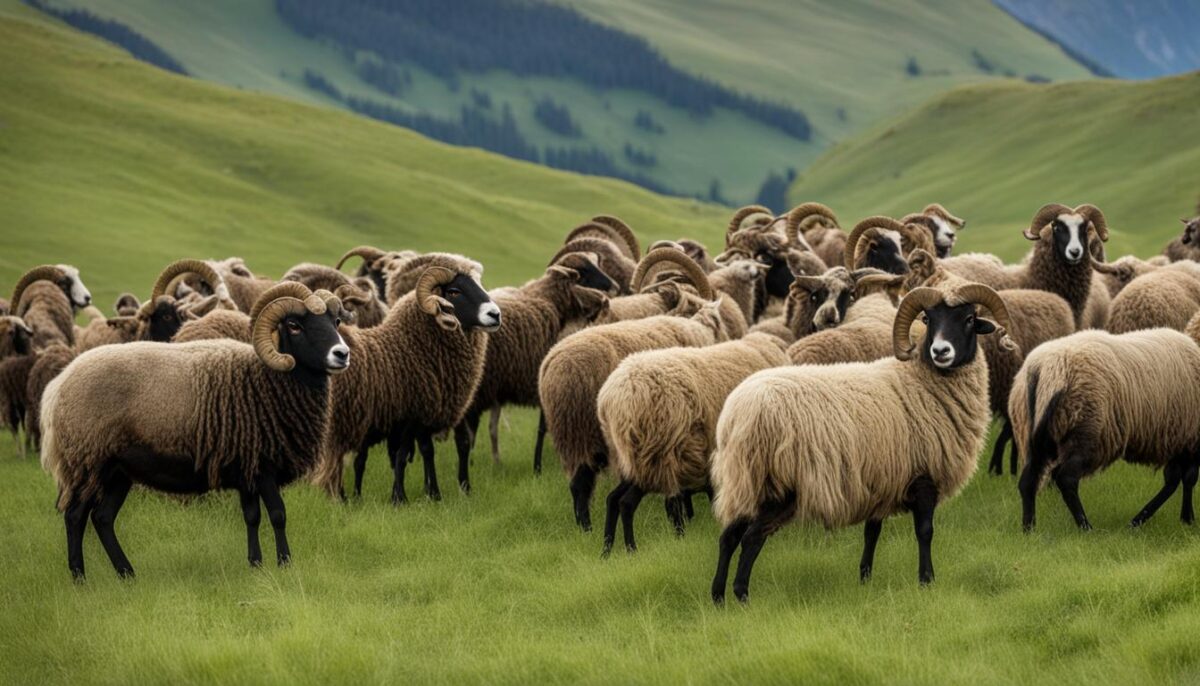
The Domestication of Sheep
One of the most significant steps in human civilization was the domestication of animals. Among the first animals to be domesticated were sheep, which provided humans with a renewable source of wool, meat, and milk. The domestication process of sheep has spanned thousands of generations, resulting in over a thousand types of domestic sheep today.
The primary purpose of domesticating sheep was to enhance wool production. Through selective breeding, humans have been able to overproduce fleece and prevent the yearly natural shedding that wild sheep experience. This has allowed for a consistent supply of wool, which has been used in various textiles and clothing for centuries.
While wool production is the primary reason for domesticating sheep, other valuable resources are derived from them as well. Sheep meat, also known as lamb or mutton, is a significant source of protein in many cultures around the world. Additionally, sheep milk is used to make various dairy products such as cheese and yogurt, offering a nutritious alternative to cow’s milk.
The domestication of sheep has revolutionized various industries, providing humans with a steady supply of wool, meat, and milk. Through the selective breeding process, domestic sheep have been specifically developed to serve these purposes, making them invaluable to human civilization.
The Benefits of Domestic Sheep
The domestication of sheep has brought numerous advantages to human societies. Firstly, sheep are a valuable source of income for farmers, as they can be raised for their products year-round. The wool, meat, and milk derived from sheep contribute to the livelihoods of many individuals involved in the agricultural industry.
Furthermore, sheep are well-suited for a variety of environments and can be raised in diverse geographical locations. Their ability to forage on different types of vegetation allows them to adapt to various climates and habitats, making them an accessible livestock option for farmers worldwide.
Domestic sheep have not only provided humans with essential resources but have also played a crucial role in sustainable agriculture and economic stability.
Table: Comparison of Wild Sheep and Domestic Sheep
| Wild Sheep | Domestic Sheep | |
|---|---|---|
| Wool Production | Naturally shed once a year | Continuously growing fleece due to selective breeding |
| Meat | Lean and gamey | Tender and flavorful |
| Milk | Not applicable | Used to make various dairy products |
| Adaptability | Well-adapted to specific wild habitats | Can thrive in various environmental conditions |
The table above compares various aspects of wild sheep and domestic sheep. It highlights the differences in wool production, meat characteristics, milk availability, and adaptability to different environments. These distinctions illustrate how domestication has shaped sheep for the specific needs and preferences of humans.
Free-Range Sheep Farming
Free-range sheep farming offers numerous advantages for both the well-being of the sheep and the quality of their products. By allowing sheep to roam freely, farmers provide them with the opportunity to engage in natural behaviors, socialize with other sheep, and explore larger areas for grazing. This freedom of movement contributes to the overall health and happiness of the sheep, resulting in better-quality wool, meat, and milk.
Sheep that are raised in a free-range environment tend to live longer and exhibit lower stress levels compared to those raised in confined spaces. The ability to move and exercise freely helps maintain their physical health, preventing issues such as obesity and joint problems. Additionally, free-range sheep have access to a more diverse range of vegetation, leading to a more balanced diet and improved nutritional intake.
From an environmental perspective, free-range sheep farming can be more sustainable than intensive farming methods. Sheep that are allowed to graze on open pastures can help maintain the health of the land by naturally fertilizing the soil and reducing the need for synthetic fertilizers. This approach also avoids overgrazing in specific areas, allowing for better management of the land’s biodiversity.
The Benefits of Free-Range Sheep Farming:
- Enhanced well-being and happiness of sheep
- Better-quality wool, meat, and milk
- Improved physical health and reduced stress levels in sheep
- Access to a diverse range of vegetation for a balanced diet
- Reduced environmental impact and increased sustainability
By embracing free-range sheep farming practices, farmers prioritize the welfare of the animals while also producing higher-quality products. This approach aligns with the growing consumer demand for ethically and sustainably sourced products, providing a competitive advantage in the market. Ultimately, free-range sheep farming offers a win-win situation for farmers, consumers, and, most importantly, the sheep themselves.
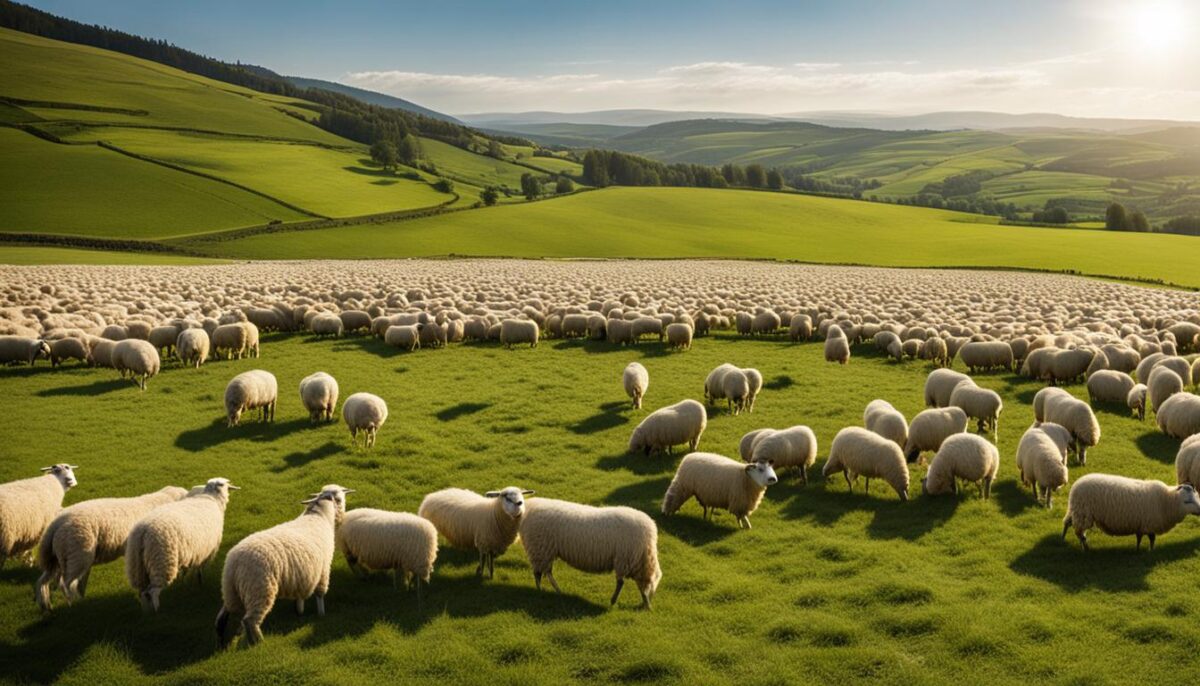
Importance of Women in Textile Production
Textile production has played a significant role in societies throughout history, and women have been central to this industry. In the pre-modern Mediterranean, textile production was mainly carried out within households, with women taking on key roles in spinning, weaving, and sewing. Their contribution to household production provided insights into the lives of historical women, reflecting their societal roles and economic significance.
Women’s involvement in textile production revealed the diverse range of skills and knowledge they possessed. They developed expertise in tasks such as carding and spinning fibers into yarn, and operating looms to weave intricate patterns. With their meticulous attention to detail and creativity, women produced textiles that were both functional and beautiful, contributing to the overall wealth and prosperity of their communities.
“Women’s dedication to textile production was a reflection of their resourcefulness and resilience.”
Household textile production was not limited to the elite; it was a common practice among women across social classes. From wealthy landowners to enslaved individuals, women from all backgrounds were engaged in textile production, adapting their techniques and materials based on their available resources. Their resourcefulness and resilience in the face of challenges demonstrated their ability to contribute to their households’ well-being and economic stability.
Table: Women’s Roles in Textile Production
| Tasks | Women’s Involvement |
|---|---|
| Spinning | Women were primarily responsible for spinning fibers into yarn, using drop spindles or spinning wheels. |
| Weaving | Women operated looms to create various types of textiles, ranging from simple fabrics to intricate patterns. |
| Sewing | Women sewed garments and other textile products, utilizing their skills in stitching and embroidery. |
| Carding and Dyeing | Women prepared fibers for spinning by carding them and often played a role in dyeing textiles with natural or synthetic dyes. |
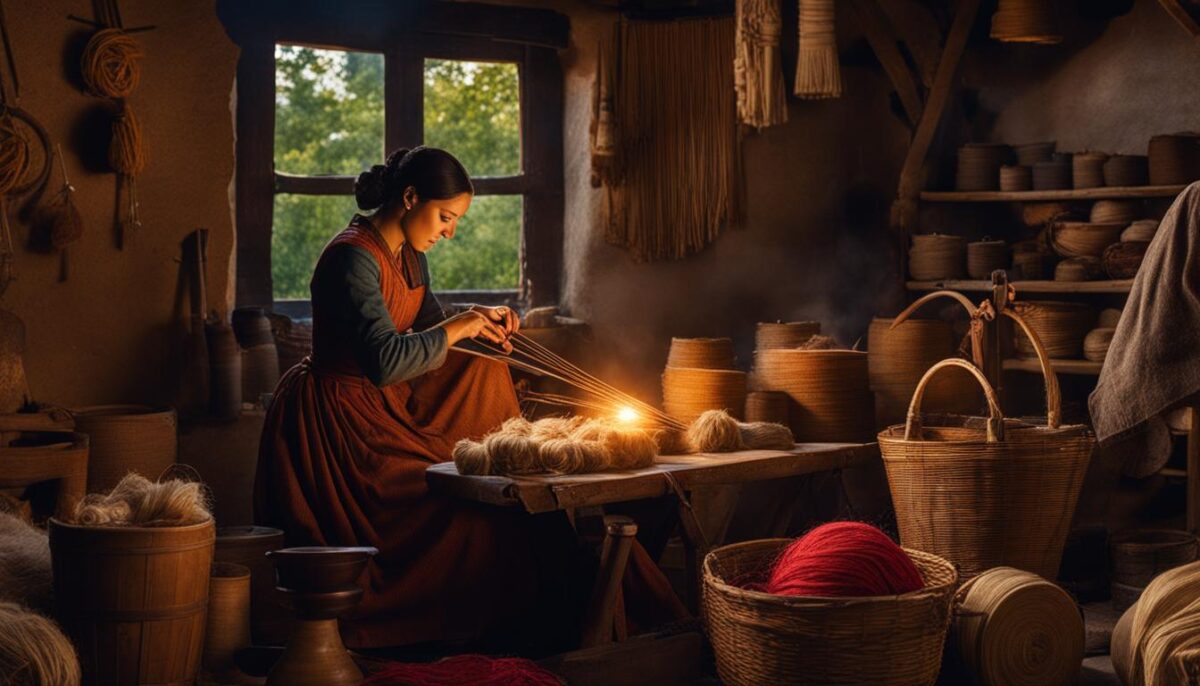
Women’s involvement in textile production was a testament to their ingenuity and determination. It provided them with a means to contribute to their households’ economic well-being while showcasing their creativity and skill. Through their involvement in spinning, weaving, and sewing, women shaped the fabric of society and left a lasting legacy in the history of textile production.
Conclusion
Wild sheep possess an incredible adaptation that allows them to naturally shed their wool, enabling them to adapt to the changing seasons. This shedding process ensures their survival in harsh weather conditions. Their ability to navigate challenging terrains and defend themselves against predators further enhances their chances of survival in the wild.
On the other hand, domestic sheep have undergone extensive selective breeding for wool production over thousands of years. This has led to the development of over 1,000 types of domestic sheep, each with its unique characteristics. The domestication of sheep has played a crucial role in meeting the demands of wool, meat, and milk production.
Additionally, women have played a significant role in textile production throughout history. In the pre-modern Mediterranean, women were primarily responsible for spinning, weaving, and sewing. Through household textile production, women were able to contribute to society and provide valuable insights into their lives and contributions.
In conclusion, the wool shedding process in wild sheep, along with their remarkable adaptation and defensive abilities, allows them to thrive in diverse environments. The domestication of sheep has led to the development of various types of domestic sheep, fulfilling human needs for wool, meat, and milk production. Moreover, women’s significant contributions to textile production have shed light on their vital role in society throughout history.
FAQ
How do wild sheep lose their wool?
Wild sheep undergo a natural shedding process that allows them to lose their wool. Unlike domestic sheep, wild sheep can survive without human intervention and have evolved to adapt to changing seasons and harsh weather conditions.
How do wild sheep defend themselves?
Wild sheep have developed horns and hooves for self-defense. Their horns serve the dual purpose of defending against predators and establishing dominance within the herd. Additionally, their strong hooves allow them to navigate challenging terrain and kick potential predators.
What do wild sheep eat?
Wild sheep graze on mountaintops, feeding on the abundance of flora in the spring and summer. During times of food scarcity, they can survive on small amounts of flora found between rocks and under thin snow.
How many species of wild sheep are there?
There are four identified species of wild sheep: Dall sheep, Bighorn sheep, Stone sheep, and Desert bighorn sheep. Each species has unique characteristics and adaptations that allow them to survive in their specific habitats.
How are domestic sheep different from wild sheep?
Domestic sheep have been selectively bred for wool, meat, and milk production over thousands of years. Unlike wild sheep, domestic sheep have lost their natural shedding process and rely on human intervention for shearing. There are over 1,000 types of domestic sheep compared to the four identified species of wild sheep.
What are the advantages of free-range sheep farming?
Free-range sheep farming allows sheep to roam freely, providing several advantages. Sheep live longer and are happier when they have the freedom to socialize, travel, and graze in larger areas. Free-range sheep also tend to be healthier and produce better-quality products. Farmers who practice free-range sheep farming often save money on sheep feed, making it a more cost-effective and sustainable approach.
What role did women play in textile production?
In the pre-modern Mediterranean, women played a crucial role in household textile production. They were primarily responsible for spinning, weaving, and sewing. Textile production provided valuable insights into the lives of historical women, highlighting their societal contributions and roles.


